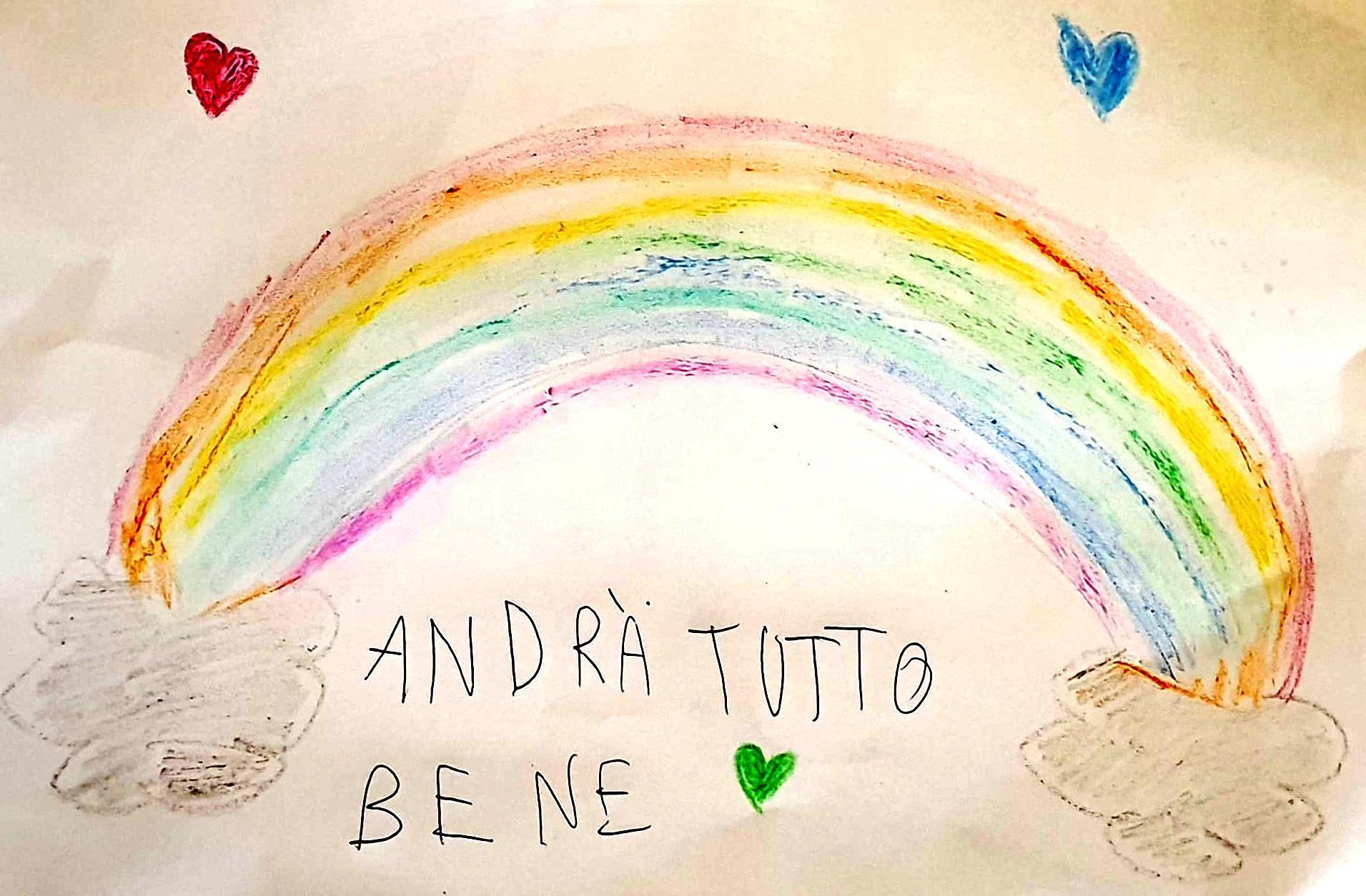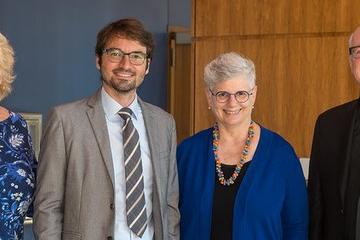
By Donna Orsuto
ROME - In the early days of the coronavirus crisis, Laura, a Lay Centre staff member, created a designated “coronavirus crisis WhatsApp group” to facilitate contact among those of us who are involved in the day-to-day running of The Lay Centre during these unprecedented days. She named it, “Tutto andrà bene.”
My first reaction as someone who teaches medieval spirituality was, “Wow, Laura is quoting the 14th-century mystic Julian of Norwich!”
The fact is that this simple but beautiful phrase is now a powerful slogan and has been one of the strongest signs of hope in Italy during this moment of crisis.
Who created the slogan?
Apparently, children in Puglia, a region in southern Italy, started this trend by drawing pictures of a rainbow and writing the words, “Tutto andrà bene” or “Andrà tutto bene,” all will be well. Laura’s eight-year-old daughter, Erica, also demonstrated her artistic skills as seen above in the image chosen as The Lay Centre Easter greeting. Similar drawings were first hung from balconies and windows and then quickly went viral on social media. Rainbows are everywhere, thanks to millions of children stuck at home because schools and nurseries are closed. These words resonate throughout the streets and are now the motto of an informal movement all over the country. A tangible sign of hope!
Signs of hope are what we need in this moment. Rainbows are typically a sign of hope, because they often appear when the sun comes back after heavy storms. They symbolize spiritual awakening, joy and hope. As a tour guide from Venice told The Guardian, “The slogan doesn’t mean ‘relax, stop being vigilant’, it means ‘Don’t give up!’”
“All will be well” in the 14th century
Laura and other Italian friends may not realize that the 14th-century mystic Julian of Norwich coined this phrase in her “Revelations of Divine Love.” Julian lived in a time when suffering and death were woven into the fabric of everyday life. Though we have scant knowledge about this woman, we know that she survived the Great Pestilence — the bubonic plague — that struck East Anglia, England, at least three times in her lifetime. Though demographers differ on the exact number of deaths, most agree today that at least one-third toperhaps half of the population died.
Julian also experienced physical suffering. At the age of 33, on May 13, 1373, she had a life-threatening illness. The exact nature of that illness is unknown, but it was a near-death experience. As she was lifted from the brink of death, she received 16 visions of Christ Crucified and came to understand in a profound way how God’s love for her and for all of humanity was revealed in Jesus dying on the cross. This became known as the “Short Text.” After years of prayer and reflection on these visions, she came to an even greater understanding of God’s love: it was the firm conviction that, no matter what happens, “Love was his meaning.” The fruit of this greater understanding, a type of expanded commentary on her earlier visions, is found in the “Long Text” or “A Revelation of Love.” As Jane F. Maynard notes in her book, “Transfiguring Loss, Julian of Norwich as a Guide for Survivors of Traumatic Grief”: “As a result of her vision, Julian came to believe that the experience of suffering may be transfigured through the presence of love…. In Julian’s view, the Incarnation and Crucifixion of Christ guarantee that God’s love is present in all human suffering since Christ’s Passion and death embrace all human pain.”
At some point after her near-death experience, Julian became an anchoress attached to the Church of St. Julian in Norwich. As a female recluse, Julian most probably lived permanently in her anchorhold or cell until her death. The anchorhold was meant to be her “tomb.” Julian embraced a lifestyle where she celebrated her death before physically dying. This was not a morbidly sad or eccentric lifestyle. It was a way of expressing her deep longing and desire for God. Her life was not wasted; on the contrary, it was a life surrendered to God that included counsel and intercession for those around her. To quote Grace Jantzen, “The anchorhold may be a tomb, but it is also a womb: a womb in which Christ comes to new birth in the anchoress, and through her in the world.”
“All will be well” and the Easter Proclamation, “Christ is Risen”:
So, what is the context of the oft-quoted phrase, “All will be well”? What does it have to do with the Resurrection that we celebrate this Eastertide? What does it mean to us today as we stand together - embracing fully the admonition to do so with acceptable social distancing - to proclaim with one heart and voice that Jesus is risen?
Julian’s “all will be well” is not the result of pious platitudes or superficial optimism. She was a realist. She knew that sin and suffering are a frightening reality and that we are indeed a “marvelous mixture of wellbeing and woe,” but she was convinced that when all is finally revealed by God, we will discover that divine love was at work even in the context of evil. As Bernard McGinn explains, this divine love is “not causing it (the nothing of sin cannot have a cause) but suffering it (both in the sense of “allowing” and “undergoing”) in the Passion of Jesus, as well as in the sin, pain, and suffering of all humans who are one in the God-man.”
Julian invites us to trust and to surrender to God no matter what happens. In the midst of suffering and death, Julian hears these words:
“I may make all things well, and I can make all things well, and I shall make all things well, and I will make all things well: and you will see for yourself that every kind of thing will be well.”
She was never given the details of exactly how this will happen, except the assurance that God has planned a great deed where suffering and pain will come to an abrupt end. She hears Christ say:
“Suddenly you will be taken out of all your pain, all your sickness, all your unrest and all your woe. And you will come up above, and you will have me for your reward, and you will be filled with joy and bliss. . . .”
Thus, in this present life Julian encourages us to be courageous and to trust in the abiding love of God. Jesus who died for us and who is risen from the dead is the one who gives us the assurance that “all will be well.” He can be trusted.
So, whether you are touched by eight-year-old Erica or by the 14th-century mystic Julian of Norwich, I hope that you will find courage in these words, because you can really count on them. “Tutto andrà bene.” All will be well.
Original drawing by Erica
For further reading:
Watson, Nicholas and Jenkins, Jacqueline (eds). The Writings of Julian of Norwich: A Vision Showed to a Devout Woman and A Revelation of Love. University Park PA: Pennsylvania State University Press. 2006.
Jantzen, Grace. Julian of Norwich: Mystic and Theologian. London, SPCK. 1999 2nd ed.
McGinn, Bernard. The Varieties of Vernacular Mysticism 1350-1550. New York, A Herder and Herder Book, The Crossroad Publishing Company, 2012.
Maynard, Jane. Transfiguring Loss. Julian of Norwich as a Guide for Survivors of Traumatic Grief. Cleveland: The Pilgrim Press, 2006.

